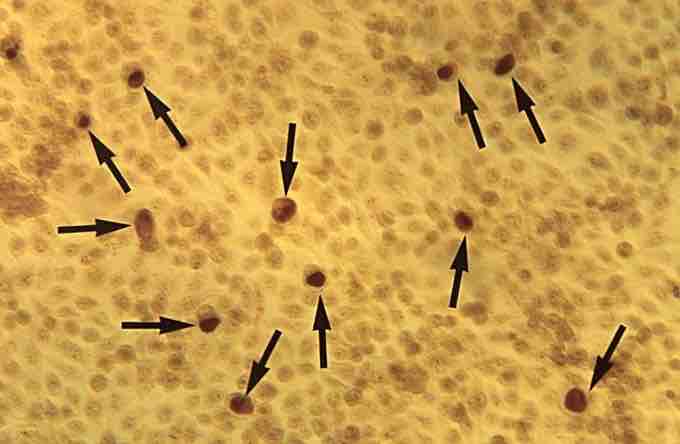Staining is a technique used in microscopy to enhance contrast in a microscopic image. Stains and dyes are frequently used to highlight structures in microbes for viewing, often with the aid of different microscopes. Stains may be used to define and examine different types of microbes, various stages of cellular life (e.g., the mitotic cycle), and even organelles within individual cells (e.g., mitochondria or chloroplasts).
In-vivo staining is the process of dyeing living tissue -- in vivo means "in life" (as contrasted to in-vitro staining). When a certain cell or structure takes on contrasting color(s), its form (morphology) or position within a cell or tissue can be readily seen and studied. The usual purpose is to reveal cytological details that might otherwise not be apparent; however, staining can also reveal where certain chemicals or specific chemical reactions are taking place within cells. In-vitro staining involves coloring cells or structures that have been removed from their biological context. Certain stains are often combined to reveal more details and features than a single stain could reveal alone, and a counterstain is a stain that increases visibility of cells or structures when the principal stain is not sufficient. Scientists and physicians can combine staining with specific protocols for fixation and sample preparation and can use these standard techniques as consistent, repeatable diagnostic tools.
There are an incredible number of stains that can be used in a variety of different methods. What follows here are some common aspects of the process of preparing for in-vitro staining.
- Fixation: This can itself consist of several steps. Fixation aims to preserve the shape of the cells (in this case, microbes) as much as possible. Sometimes heat fixation is used to kill, adhere, and alter the cells so they will accept stains. Most chemical fixatives generate chemical bonds between proteins and other substances within the sample, increasing their rigidity. Common fixatives include formaldehyde, ethanol, methanol, and picric acid.
- Permeabilization: This involves treatment of the cells with (usually) a mild surfactant. This treatment dissolves cell membranes, allowing larger dye molecules to enter the cell's interior.
- Mounting: This step usually involves attaching the samples to a glass microscope slide for observation and analysis. In some cases, cells may be grown directly on a slide. For samples of loose cells the sample can be directly applied to a slide.
At its simplest, the actual staining process may involve immersing the sample (before or after fixation and mounting) in dye solution, followed by rinsing and observation. Many dyes, however, require the use of a mordant -- a chemical compound that reacts with the stain to form an insoluble colored precipitate. When the excess dye solution is washed away, the mordanted stain remains. There is an incredible array of stains that can be used at this step, from those that stain specific microbial types (see the figure below) to those that highlight sub-compartments or organelles of a cell, such as the nucleus or endoplasmic reticulum. Alternatively, negative staining can be employed. This is a simple staining method for bacteria, performed by smearing the cells onto the slide and then applying nigrosin (a black synthetic dye) or Indian ink (an aqueous suspension of carbon particles). After drying, the microorganisms may be viewed in bright field microscopy as lighter inclusions contrast well against the dark environment surrounding them

Chlamydia Stain
Cells of the bacterial pathogen chlamydia (indicated by arrows) are highlighted by a stain called "geimsa. "
Live, in-vivo staining microscopy shares many of these steps, with the exception of fixation, which invariably kills the microbe to be examined.